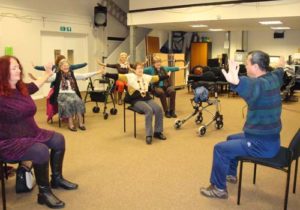Reduce Anxiety and Depression in Patients with Spinal Cord Injury with Mindfulness
By John M. de Castro, Ph.D.
“For people with spinal cord injury, the Mindfulness for Health course was effective in reducing symptoms of depression, anxiety, pain unpleasantness, and pain catastrophizing.” – Breathworks
“Spinal cord injury (SCI) occurs when the spinal cord is damaged (such as through traumatic injury), and often leads to partial or complete loss of motor and/or sensory function below the level of injury.” Spinal cord injury is devastating to the individual. It results in a permanent cutting off the central nervous system from control of the muscles of the body and as a result paralysis. The severity of the paralysis depends on the location of the injury of the spine with the higher up the injury is on the spine the more widespread the paralysis. In the U.S. there are approximately 17,000 new cases of spinal cord injury each year. The World Health Organization summarizes the problem: “Every year, around the world, between 250 000 and 500 000 people suffer a spinal cord injury (SCI)”.
Beyond, the devastating physical consequences of spinal cord injury are difficult psychological, behavioral, emotional, and social issues. The vast majority of patients experience chronic pain and a decreased quality of life. In addition, depression and anxiety disorders are common. Since, spinal cord injury is permanent, it is important to address the pain and psychosocial consequences of the injury that may be present throughout the lifetime. Mindfulness training may help. It has shown to be effective in reducing chronic pain, treat depression and anxiety disorders, and improve quality of life following a variety of diseases. Hence, it would seem reasonable to examine the ability of mindfulness training in treating the psychological consequences of spinal cord injury.
In today’s Research News article “Mindfulness for pain, depression, anxiety, and quality of life in people with spinal cord injury: a systematic review.” (See summary below or view the full text of the study at: https://www.ncbi.nlm.nih.gov/pmc/articles/PMC6971852/), Hearn and Cross review and summarize the published research studies of the effectiveness of mindfulness training for the pain and psychological issues resulting from spinal cord injury. They identified 5 published research studies employing a variety of mindfulness -based intervention techniques including yoga practice.
They report that the published studies found that mindfulness training produced significant decreases in depression and anxiety in the patients. Overall, however, the studies did not report significant improvements in pain or quality of life. A limiting factor is that the quality of the study methodologies and analyses were low with only one randomized controlled study.
Hence, the results suggest that mindfulness-based intervention improve the mental health of spinal cord patients. This is important as depression, in particular, is a serious problem with patients with spinal cord injuries. There is a need for more, larger, and better controlled trials in the future.
So, reduce anxiety and depression in patients with spinal cord injury with mindfulness.
“mindfulness training intervention for people with reduced sensory and motor function arising from SCI. . . offered greater improvements in symptoms of depression and anxiety, pain catastrophizing.” – Jasmine Heath Hearn
CMCS – Center for Mindfulness and Contemplative Studies
This and other Contemplative Studies posts are also available on Google+ https://plus.google.com/106784388191201299496/posts and on Twitter @MindfulResearch
Study Summary
Hearn, J. H., & Cross, A. (2020). Mindfulness for pain, depression, anxiety, and quality of life in people with spinal cord injury: a systematic review. BMC neurology, 20(1), 32. https://doi.org/10.1186/s12883-020-1619-5
Abstract
Background
Populations with reduced sensory and motor function, such as spinal cord injury (SCI) are at increased risk of depression, anxiety, pain, and poorer quality of life (QoL). Mindfulness-Based Interventions (MBIs) have been developed with the aim of improving outcomes for people with SCI. To understand the value of MBIs, a systematic review was conducted pertaining to the use of MBIs, and interventions including elements of mindfulness, with people with SCI.
Methods
Databases were reviewed from 1996 to October 2018 (updated January 2020). Eligibility criteria included the assessment of at least one of the common secondary consequences of SCI (i.e. risk of depression, anxiety, pain, and QoL), describe the use of mindfulness training as a component part of an intervention, or as the whole intervention. The Cochrane Collaboration Risk of Bias and The Effective Public Health Practice Project Quality Assessment Tools were utilised for quality appraisals. Two assessors appraised the studies and demonstrated good agreement (Cohen’s k = .848, p < .001).
Results
Five papers met the inclusion criteria, and demonstrated a range of results of interventions delivered individually, in a group format, in person, and online. Only one study reported significant reductions in pain-related outcomes (with moderate effect sizes), with the remaining studies (n = 4) demonstrating no change. Four studies described reductions in depressive symptoms and three reported reductions in anxiety. Despite the importance of good QoL as a goal for people with SCI, few studies (n = 2) assessed this as an outcome with no improvements reported. Study quality ranged from high to low/weak.
Conclusions
The findings in this review provide mixed support for the use of mindfulness to improve outcomes after SCI. In particular, findings indicate that mindfulness may be particularly effective for improving symptoms of depression and anxiety. This review highlights the requirement for more rigorous, high-quality research, particularly larger randomised-controlled trials with long-term follow-up, in this area. The small number of studies included in the present review mean that conclusions drawn are preliminary and thus reflects the paucity of the research in the area to date.
https://www.ncbi.nlm.nih.gov/pmc/articles/PMC6971852/


